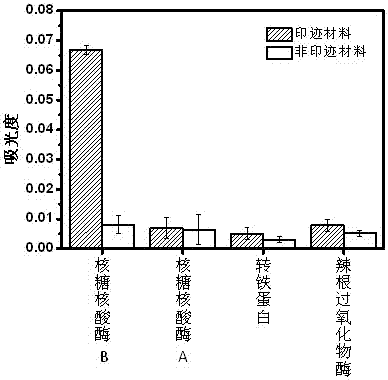Preparation method and application of lectin mimics based on molecular imprinting technology
A technology of molecular imprinting and lectin, which is applied in the field of molecularly imprinted functional materials, and achieves wide application prospects, low cost, and good recognition ability
- Summary
- Abstract
- Description
- Claims
- Application Information
AI Technical Summary
Problems solved by technology
Method used
Image
Examples
Embodiment 1
[0035] Example 1: Obtaining of sugar chains (imprinted template molecules)
[0036] Firstly, the intact glycoprotein was dissolved in 10mM ammonium bicarbonate buffer solution (pH 7.5) to prepare a 1mg / mL mixed solution. Take 100 μL of the above mixed solution and immerse it in a boiling water bath for 10 minutes, take it out and cool it down to 25°C naturally, then add 10 units of peptide-N-glycosidase F and react in a water bath at 37°C for 24 hours. After the reaction, sugar chains were separated from the reaction system by centrifugation at a speed of 14,000 rpm for 30 minutes with an ultrafiltration tube with a molecular weight cutoff of 3,000 Daltons. The obtained sugar chains were stored at -20°C until use.
[0037] The above-mentioned intact glycoprotein is ribonuclease B, or transferrin; or other glycoproteins.
[0038] The above-mentioned peptide-N-glycosidase F is an enzyme used to enzymatically cut off the sugar chain on the complete glycoprotein.
Embodiment 2
[0039] Example 2: Preparation of 2,4-difluoro-3-formyl-phenylboronic acid modified magnetic nanoparticles
[0040] First prepare an amino-modified magnetic nanoparticle [for the preparation method, see but not limited to the following documents L.Wang, J.Bao, L.Wang, F.Zhang, Y.Li, Chem.Eur.J. "European Chemistry" 2006 , 12, 6341-6347]. 200 mg of amino-modified magnetic nanoparticles were added to 40 mL of anhydrous methanol, followed by 400 mg of 2,4-difluoro-3-formyl-phenylboronic acid and 400 mg of sodium cyanoborohydride. The mixture was stirred and reacted at 25°C for 24 hours. The obtained product was washed three times with water and ethanol respectively, and dried under vacuum at 50° C. for 12 hours. That is, magnetic nanoparticles modified with 2,4-difluoro-3-formyl-phenylboronic acid are obtained.
Embodiment 3
[0041] Embodiment 3: the investigation of imprinted coating thickness change relation with time
[0042] Silver nanoparticles with a particle size similar to that of the magnetic nanoparticles were added to a mixed solution of 40 mL of absolute ethanol and 0.7 mL of concentrated ammonia water (37%). Finally, 10 mL of 10 mM tetraethyl orthosilicate in ethanol was added. Stir at 25°C, from 10 minutes to 60 minutes after stirring, samples are taken every 5 minutes, and the thickness of the imprinted coating on the surface is characterized by a transmission electron microscope. The result is as figure 2 . The linear correlation coefficient r in the figure 2 =0.99, the slope s=0.04nm / min, which shows that the thickness of the polymer has a good linear correlation with the time growth, which provides a guarantee for the controllability of the technology.
PUM
 Login to View More
Login to View More Abstract
Description
Claims
Application Information
 Login to View More
Login to View More - R&D
- Intellectual Property
- Life Sciences
- Materials
- Tech Scout
- Unparalleled Data Quality
- Higher Quality Content
- 60% Fewer Hallucinations
Browse by: Latest US Patents, China's latest patents, Technical Efficacy Thesaurus, Application Domain, Technology Topic, Popular Technical Reports.
© 2025 PatSnap. All rights reserved.Legal|Privacy policy|Modern Slavery Act Transparency Statement|Sitemap|About US| Contact US: help@patsnap.com



